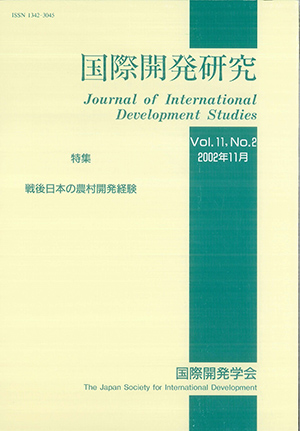Volume 11, Issue 2
Displaying 1-18 of 18 articles from this issue
- |<
- <
- 1
- >
- >|
Special Issue : Rural Development Experience in Post-War Japan
-
2002Volume 11Issue 2 Pages 1-3
Published: November 15, 2002
Released on J-STAGE: March 28, 2020
Download PDF (143K)
Articles
-
2002Volume 11Issue 2 Pages 5-24
Published: November 15, 2002
Released on J-STAGE: March 28, 2020
Download PDF (1115K) -
2002Volume 11Issue 2 Pages 25-38
Published: November 15, 2002
Released on J-STAGE: March 28, 2020
Download PDF (809K) -
2002Volume 11Issue 2 Pages 39-51
Published: November 15, 2002
Released on J-STAGE: March 28, 2020
Download PDF (777K) -
2002Volume 11Issue 2 Pages 53-66
Published: November 15, 2002
Released on J-STAGE: March 28, 2020
Download PDF (798K) -
2002Volume 11Issue 2 Pages 67-80
Published: November 15, 2002
Released on J-STAGE: March 28, 2020
Download PDF (667K)
Articles
-
2002Volume 11Issue 2 Pages 81-100
Published: November 15, 2002
Released on J-STAGE: March 28, 2020
Download PDF (1184K) -
2002Volume 11Issue 2 Pages 101-114
Published: November 15, 2002
Released on J-STAGE: March 28, 2020
Download PDF (792K) -
2002Volume 11Issue 2 Pages 115-131
Published: November 15, 2002
Released on J-STAGE: March 28, 2020
Download PDF (763K)
-
2002Volume 11Issue 2 Pages 133-147
Published: November 15, 2002
Released on J-STAGE: March 28, 2020
Download PDF (806K) -
2002Volume 11Issue 2 Pages 149-172
Published: November 15, 2002
Released on J-STAGE: March 28, 2020
Download PDF (1250K) -
2002Volume 11Issue 2 Pages 173-186
Published: November 15, 2002
Released on J-STAGE: March 28, 2020
Download PDF (579K) -
2002Volume 11Issue 2 Pages 187-200
Published: November 15, 2002
Released on J-STAGE: March 28, 2020
Download PDF (771K) -
2002Volume 11Issue 2 Pages 201-219
Published: November 15, 2002
Released on J-STAGE: March 28, 2020
Download PDF (984K) -
2002Volume 11Issue 2 Pages 221-238
Published: November 15, 2002
Released on J-STAGE: March 28, 2020
Download PDF (995K) -
2002Volume 11Issue 2 Pages 239-252
Published: November 15, 2002
Released on J-STAGE: March 28, 2020
Download PDF (643K) -
2002Volume 11Issue 2 Pages 253-268
Published: November 15, 2002
Released on J-STAGE: March 28, 2020
Download PDF (875K) -
2002Volume 11Issue 2 Pages 269-282
Published: November 15, 2002
Released on J-STAGE: March 28, 2020
Download PDF (646K)
- |<
- <
- 1
- >
- >|
